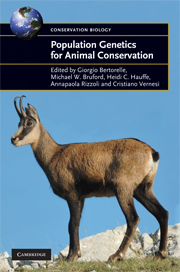Book contents
- Frontmatter
- Epigraph
- Contents
- List of contributors
- Foreword
- Acknowledgements
- 1 Introduction
- Statistical approaches, data analysis and inference
- Molecular approaches and applications
- 6 Challenges in assessing adaptive genetic diversity: overview of methods and empirical illustrations
- 7 Monitoring and detecting translocations using genetic data
- 8 Non-invasive genetic analysis in conservation
- 9 The role of ancient DNA in conservation biology
- From genetic data to practical management: issues and case studies
- Future directions in conservation genetics
- Software index
- Species index (common name)
- Species index (Latin name)
- Subject index
6 - Challenges in assessing adaptive genetic diversity: overview of methods and empirical illustrations
from Molecular approaches and applications
Published online by Cambridge University Press: 05 July 2015
- Frontmatter
- Epigraph
- Contents
- List of contributors
- Foreword
- Acknowledgements
- 1 Introduction
- Statistical approaches, data analysis and inference
- Molecular approaches and applications
- 6 Challenges in assessing adaptive genetic diversity: overview of methods and empirical illustrations
- 7 Monitoring and detecting translocations using genetic data
- 8 Non-invasive genetic analysis in conservation
- 9 The role of ancient DNA in conservation biology
- From genetic data to practical management: issues and case studies
- Future directions in conservation genetics
- Software index
- Species index (common name)
- Species index (Latin name)
- Subject index
Summary
INTRODUCTION
Since its inception, the concept of ‘evolutionarily significant unit’ (ESU) has had several theoretical definitions differing mainly on the emphasis given to neutral versus adaptive genetic diversity (Ryder 1986; Waples 1991; Moritz 1994; Crandall et al. 2000; reviewed in Fraser and Bernatchez 2001). The ‘neutral’ definition highlights a genetic background shaped over a long-term evolutionary time scale by evolutionary forces such as genetic drift and migration (Moritz 2002). In contrast, the ‘adaptive’ definition underlines the existing, adaptively significant phenotypic variation resulting from the ongoing action of natural selection (McKay and Latta 2002; van Tienderen et al. 2002). Thus, neutral and adaptive diversities depict distinct temporal realms (Fig. 6.1) and should be assessed separately and differently (Bowen 1999; Moritz 2002).
The neutral component of genetic diversity was the first to be investigated, coinciding with the breakthrough in the development of molecular markers and new tools and concepts in phylogeography and population genetics. A wide range of methods is currently available to measure neutral genetic variability, which has resulted in crucial answers to several key conservation issues (see examples in Frankham et al. 2002). In contrast, characterizing adaptive genetic variation remains challenging (van Tienderen et al. 2002; Vasemägi and Primmer 2005), requiring the identification of a small number of adaptive loci scattered throughout the genome (Black et al. 2001). Moreover, molecular markers are generally assumed to be neutral and they have been shown to be poor indicators of adaptive genetic diversity (Merilä and Crnokrak 2001; Reed and Frankham 2001; McKay and Latta 2002). Given this background, we review here different strategies that can be adopted to reveal genetic polymorphisms with an adaptive role. The goal of this chapter is not to present an exhaustive and detailed list of existing methods, but rather to highlight the underlying principles of those we believe to be the most useful and/or readily applicable, as well as their advantages and drawbacks. Several examples relevant to conservation are also presented.
- Type
- Chapter
- Information
- Population Genetics for Animal Conservation , pp. 123 - 147Publisher: Cambridge University PressPrint publication year: 2009
- 2
- Cited by



